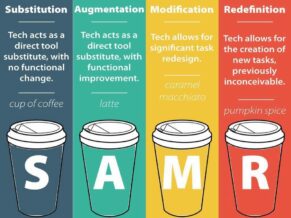Special thanks to ETT Summit Presenter, Sabba Quidwai (@askmsq). She will be presenting Cast a Spell to Flip Your Class with TouchCast.
In the Passenger Seat
Placing students in the driver’s seat, guiding their own learning as the educator facilitates from the sidelines is sometimes uncomfortable. If you have taught anyone how to drive, you know the feeling quite well. It’s easy to have the new driver in the passenger seat showing them what all the different gears and buttons are for. It’s easy to be driving and explaining why you are yielding or why you are turning your indicator light on at a certain time. However, when you switch sides and place the learner in the driver’s seat, all of a sudden, it’s not so easy anymore. In fact, the loss of control is often frightening.
Will they brake in time? Will they yield for that pedestrian about to cross the road? Will they change lanes smoothly?
Perhaps the hardest of all is, as the “expert” driver in the passenger seat, you have to resist the urge to jump in and tell them what to do at each and every turn. They can watch others drive, read the DMVs handy booklet, and score perfect marks on the written exam; however, it is not until they are in the driver’s seat applying the content learned that they will develop the skills required to be out on the road on their own.
Why then should the classroom be any different? As designers of the learning experience in your classroom how are you allowing your students to master and apply the skills needed to thrive in today’s ever changing world?
Understanding by Design
Time and time again, I hear educators talk about all the things they wish they could do in their classroom. I would love for my AP students to do projects and apply their knowledge but I have to lecture through 44 chapters. I would love to do more writing in the history classroom, but I have too much content to cover, and the list goes on and on. Students spend a significant part of their day in our classrooms, and if we had to showcase the learning experiences we design, how proud would we be of what appeared on the runway?
The Understanding by Design Model by Grant Wiggins and Jay McTighe presents educators with a backwards design model that allows us to thoughtfully select and design the learning experiences for our student’s by reflecting upon three steps:
The rise of mobile technology, particularly iPad, redefines the power of a student’s ability to demonstrate what they know. However, as exciting as all of this sounds, many educators once again come back to the issue of time.
We often think of time in the classroom as belonging to the educator. We often forget that there are many other people in the room who also value their time. One of the great responsibilities I believe we have as educators is respecting students time by providing them with meaningful and relevant learning experiences. Let’s take a look at the flipped classroom that allows learners to travel on a path described by the EdTechTeacher team as one of consumption to creation.
The Flipped Classroom
The flipped classroom is a method where teachers post videos of lectures for homework, and when students come to class, they can ask questions and engage in activities that allow them to demonstrate what they have learned. However, it is important to reflect upon how it is being used to enhance the learning experience. When reflecting upon the use of technology, the SAMR model by Dr. Ruben Puentedura is extremely helpful.
When creating a screencast or selecting a video for students to view ask, “Am I using this as a substitution? Am I merely recording myself as the sage on the stage and asking students to watch at home instead of watching me in the classroom? Or am I redefining the way in which content is being shared?”
I struggled deeply with the idea of just a recording, especially if it wasn’t one I had created. I definitely believe in not having to reinvent the wheel, but I also believe in building a rapport and relationship with students. Just because I wasn’t sharing content in the classroom didn’t mean that I shouldn’t be a part of it. I wanted to facilitate their learning at home by being able to pose questions and guide their learning.
Everything came together when I found Touchcast. Touchcast allows me to merge together videos and the web together all while being part of the presentation. It redefines the meaning of delivering content for students to view at home. I can use it to take students on a journey of the past as they explore videos, sources and sites. They can choose what they would like to investigate further.
When we meet back in class, instead of having a group of students who have each spent time watching the same video, I have students who have explored different resources and are able to share their knowledge leading to deeper levels of conversations. I no longer spend my classroom time laying the foundation for ideas, we spend our time investigating, collaborating and creating. It is this investigation that allows students to engage in their world, engage in current events and engage in the exploration of their talents. It is this investigation that allows students to develop key skills like being able to articulate their point of view, collaborate and work as a team, identify their strengths and develop their weaknesses. This is the potential of the flipped classroom.
https://www.youtube.com/watch?v=BjIpSNNRa1c
Credit: Fairmont Education Group
Tomorrow, when the world is different from when students of today were in school will they have the skills to navigate changes that come their way. As Patrick Larkin says, “Stay uncomfortable!” Place the student in the drivers seat as together you discover, innovate and share.

